Somayeh Ramezanmahi 1, Hasan Bolkhari Ghehi 2
1MA in Illustration, College of Fine Art, University of Tehran, Tehran, Iran
2Associate Professor of University of Tehran
Correspondence to: Somayeh Ramezanmahi , MA in Illustration, College of Fine Art, University of Tehran, Tehran, Iran.
| Email: |  |
Copyright © 2014 Scientific & Academic Publishing. All Rights Reserved.
Abstract
According to the bases of the art if the East, the artist tries to manifest the absolute essence of God in his artistic works, and the imaginary motifs and forms depicted in his works narrate the light of God. In principle, the artist is not bound to imitate nature and uses symbol to represent the metaphysical universe and its existing truths. Symbol represents a transcendental reality embracing deep concepts, whose cognition helps to understand the substance of the Islamic thoughts and to be enjoyed of its internal beauty. Illustration and iconography of fire is the depiction of one of these symbols. Indeed, the fire painted in Iranian miniature is not the representative of fire as one of the four elements, rather a symbol of the sacredness and light of the saints of God. In this research, it is aimed the study the mystical attitudes towards light and fire in order to understand better the meanings of fire. Among the different miniature manuscripts narrating this story, MirajNameh has been selected for this purpose, since this book contains illustrations of the material world, seven heavens, paradise, and hell simultaneously. This research aims to prove that the artist has been visually aware of the different types of fire and light, although it cannot be claimed that he was fully informed of the mystical meaning of such distinction. It is however clear that this attitude followed in the visual tradition of Iranian bookmaking is of great significance.
Keywords:
Fire, Light, MirajNameh, Halo of Sacredness
Cite this paper: Somayeh Ramezanmahi , Hasan Bolkhari Ghehi , The Manifestation of Fire and Lightin the Icons of Mir-Heidar’s Miraj Nameh, International Journal of Arts, Vol. 2 No. 4, 2012, pp. 16-25. doi: 10.5923/j.arts.20120204.01.
1. Introduction
As fire and heat remind always of immortal memories saved in human being’s mind, they have become to a brilliant phenomenon for the exploitation of many ideas, feelings, and thoughts of human. Fire has not only a personal, individual, and internal aspect, but also agential, comprehensive, and general characteristics. It exists in human’s heart, and heaven, blazes from inside, manifested in form of love, and burns inside human. Fire can penetrate inside human and hide to burn human like hate and disgust. Among all phenomena, fire is indeed the only one that is involved to this extent in the life, thoughts, believes, vision, and feelings of people. This phenomenon can be manifested clearly in two forms, which are against each other. One is the symbol of the good, and the other symbol of the evil. Fire can be illuminated in the heave, and blazes in the hell. It can be both a symbol of sweat passionate love in heart, and a symbol of hate and brutality, which is bitterly devastating. About the contradictory definitions of fire, Sheik Kobra states that, “Satan is an impure fire mixed with the darkness of infidelity […]; however, any fire faced by the wayfarer is not a sign of Satan, since God is manifested sometimes in form of fire, and God’s remembrance is like fire, anything approaching such fire is caught, burnt, destroyed […], nevertheless, there is a difference between the fire, which is the remembrance of God and the fire, which is not anything except Satan; the fore of God’s remembrance is pure, dynamic, warm, and ascendant; but, the fire of Satan is dark, impure, and moving slowly.” [3]. In the said work, Sheik Kobra describes the shape and even type of the movement of pure fire and satanic one. In this paper, we aim to find out if the artist of miniature painting has been aware of such differences and applied them in the paintings, in which fire has been depicted. Indeed, the researcher seeks to research the manifestation of this concept in visual arts. Khadjeh Imam Abu Ibrahim Ismail Ibn-Muhammad MostamaliNadjari has described fire in his book titled “Sharh al-Ta’arraf Le-Mazhab al-Motesavvef” (an Introduction to Sufism) as “the contemplation of secret is like the burning of fire, which is itself the contemplation, and its sparks are signs, and the fumes of fire are like prayer” [3]. “When fire is fierce, it burns itself and others, and when it weakens, it cannot affect others. A fierce fire burns itself and others too, and it is represented by its illumination. One may observe it, and one may be burnt by it. Observation can be carried out by anybody, and burning may happen to somebody. That one who observes fire has his own attribute, and the one, who is burnt, loses such attributes. Anything that is burnt changes to another substance, which is different from the previous one before the burning [3].
2. Light
Such an attitude towards fire, its allegorical form, as well as the conversion of its forms and attributes to the spiritual and sensual state of human being, is a mystical approach. In the Islamic philosophy, the pure and divine fire is introduced by the mystic as the light, and he introduces the impure and satanic one as fire. Light and fire are two key words in the Islamic – philosophical approach. These two terms, fire (Nār) and light (Nur), which are [in Persian] audio-visually very similar, describe two opposite aspects of fire. According to the Hikmat al-Ishragh (philosophy or wisdom of illuminaiton) developed by Shahab al-Din Suhrawardi, who introduces himself as the heir of illuminative philosophy of Fahlavi, Fors, and Khosrawani philosophers, Shargh (illumination) is the orient of truth light and existence light. It must be noted that Suhrawardi, who was influenced by the legacy of illuminative philosophy of old Iran, had respect of fire, and compared its effects in the physical world with the rational soul in realm of body [16]. According to the philosophical vision of Suhrawardi, the one that affects existence is light. What is liable to possess the position of vicegerent in sensual world is equal to the fire in the physical world. Therefore, human soul is the senior vicegerent, and the element of fire is the junior vicegerent. In fact, Nur al-Anwar (the supreme light of lights) in the philosophy of illumination or Nur al-Nur(the supreme light of light) in Sufism means the Divine Essence of God, which is called Nur-e Ahmadi or Nur-e Ahad by some mystics such as Ayn al-Quzat [17]. The concept of Nur al-Anwar (the Light of Lights), which illuminates the whole worlds from one orient to another one, its rising at any level is interpreted as a discovery, has its origin in the divine essence of God, and has been present from the date of genesis to the Hereafter, is the term introduced in Avesta as Khowarna1, which has been changed today to Farrah or Farr [12]. The role of this Light is crucial in Mazdaism2 Universalogy. The greatness halo of brilliant creatures, the cohesive power of each being, the life-giving fire, personal angel, and fate of any being have their root in this Light. Xwarnaor Farrah is not only determining the substantial quality of each creature, but also organizing the universe. Xwarna is the very original power that regulated the levels of the world. Farrah is also the personal angel or fate accompanying anybody and describing his nature or special reality. The difference among various Xwarna accompanying heroes, kings, philosophers, and the prophet is due to the abovementioned fact. According to Suhrawardi, the translation of platonic ideas into the language of the celestial Mazdaism, and combination of two Iranian and Greek traditions with the Islamic and illumination (Ishragh) teachings provide significant results. One of the most important results is the comparison of Avestan halo and the light of the prophet Muhammad in the Islamic tradition. Suhrawardi merges the concept of Xwarna, the concept of Sekkina (divine tranquility) meaning the divine light in the favorites of God, and combines the Islamic tradition and angel-believing religion of Mazdaism. He also believes that the terms Xwarna, Sekkina, and the Greek work Logos are identical and develops his notion based on the combination of these traditions with each other [12].Light has affected the Islamic mysticism deeply from two viewpoints. Firstly, “the stream of existence from the divine being of God is manifested in form of light, about which the ideas of Suhrawardi have been mentioned. Secondly, the Islamic philosophers believe that the forms of the world of ideas (Alam al-Mithal) are made of light. In other words, the sufi, mystic, and artist purify themselves from the material and dimensional world during mystical ascent to enter the realm of light [5].Considering that the light in the Islamic arts including miniature is always present, this issue is discussed in this paper to survey the origins of this idea. To discuss and survey the two issues of light and fire, firstly those factors changed light to an inherent element in artistic works in the Islamic – Iranian culture are studied; secondly, the similarities and different of the images of fire and light are discussed. To describe and analyze the status of light, it is required to refer to Quran as the only divine book of Islam, since this book and prophet’s tradition are the origins of most beliefs and ideas of the Islamist mystics and philosophers. In all divine religions including Quran, light is the attribute of the absolute being; in other words, light is itself the being, and this has been manifested in Islam too. In Quran, light is the attribute of Torah, Gospel, and Quran [10].Darkness and light are two opposite concepts [10] the final destination of all believers is the light [10], the earth [in the hereafter] will be illuminated by the light of God [10] the opening of breast (Sharh-i Sadr) to Islam is again a light sent by God [10], believing men and women having their light promising them the heaven [10] and [God] has made the moon a light therein, and the sun a lamp3 [10].All these verses show the higher status of light in the Quran. Light is the attribute of God, prophets, and their books. Islam is the light, and believers are the manifestations of such a light [5]. Among the verses of the Quran referring to the issue of light, the verse 35 of the Surah al-Nur is the most important and controversial verses, attracted the attention of the Islamic philosophers as regards the light discussed in the Islamic mysticism. According to the Islamic commentators, the above mentioned verse indicates that, “God has a general light illuminate heavens and earth, by which the hidden truth is unveiled. As the reveal of something by something else requires that the revealing agent to be itself revealed, therefore, the revealing thing should be itself the light. Therefore, God is the light illuminating the heavens and earth. Perceptual lights are revealed, and they illuminate opaque and darkened objects, if they shine at them. The different is that, those objects that are revealed by the divine lights come into existence; but the reveal of the darkened objects by perceptual lights is something other than their real existence [9].Therefore, existence belongs only to the God, who is entirely the light, which has its own hierarchy and emerges in form of ideas and forms. The importance of this issue becomes known to us when we refer to the history of Islamic philosophy and mysticism, in which the levels of the universe have been explained based on the verses of the Surah al-Nur (the chapter of the Light); for example Islamic philosophers such as Avicenna, Imam Muhammad Ghazali, Sheik IshraghMulana, IbnArabi, MullaSadra have discussed this issue in their works, which requires another research4.
2.1. Light in the Islamic – Iranian Miniature
As it has been mentioned, Suhrawardi known as Sheik Ishragh has opened a new door to the philosophy of light by introducing the concepts of Farrah, Illuminated Human, and Sekkina.According to Suhrawardi, Farrah is the light emitted from the divine essence of God; it causes some people to become higher than others, and anybody possess a profession or craft […]; According to Suhrawardi, Farrah or Nur-e Jalal (light of glory) is the eternal emission of Nur al-Anwar (light of lights) throughout the whole universe, and the wayfarer must find this light […]; Farrah is classified into two groups: the Farrah of all creatures, and Kian-e Farrahi(royal light) that belongs to the kings [5].As it was explained, the word Farrah was borrowed by Suhrawardi from Zoroastrianism. According to Henry Corbin, “the light surrounding the creatures of Ahura Mazda is the light emitted from the world of sanctity. This light is the elixir of knowledge, power, and virtue, and the source of these lights introduced by Suhrawardi is certainly Xarrah the concept in the religion of Zoroastrianism [15].“The halo of light showing the essence of Xwarna […] is a substance full of absolutely illuminating light that creates the creatures of Ahura Mazda from the origin of existence” [15].The most essential characteristic of the saints of God depicted in Byzantine pictures and Manichaeic miniatures is the halo around the head of characters. However, This halo has been changed to Shamsa(sun-like motif) in the history of Iranian miniature. The use of Shamsa5 instead of the circle of lightindicates that an epistemological change: “the illuminated icon changed gradually from its objective depiction and changed to an abstract motif (which is due to the abstractness of light)” [5].After the fifth and sixth century A.H. (12th& 13th AD), this mystic vision based on color and light affected that type of art, whose ultimate was to reveal the world that was entirely veiled on the one hand, and unveil a world of light by mystical intuition on the other hand. According to Titus Burckhardt, this reminds of the secret of veil: based on the parole of Prophet Muhammad, “God is hidden behind seventy thousand veils of light and darkness. When these veils are removed, the look of God at anything and anybody will burn him due to the brilliance and luminosity”. Veils are made of light to hide the divine darkness and of darkness to veil the divine light [4]. As the Islamic art and Iranian miniature is supported by this great backing, the whole world admires such an art, “and makes your soul to dance mystically in the labyrinth of its internal secrets” [5].This is why the illuminated halo and Shamsa have been changed to the flames of fire around the head of saints of God and prophets in the culture of Islamic – Iranian miniature.
2.2. Light and Fire
The motif of fire has a mysterious meaning in all civilizations and expresses metaphysical beliefs, traditions, and usages of light and fire in different cultures. This motif is in various forms based on their stylistic nature and function. The energy and flammability of fire is shown by depicting it in a toothed and twisting form. Although the symbolic meaning of fire in the paintings of different cultures and civilizations covers a vast domain, two different but common usages are more important than others are. The motif of fire is the visual expression of divinity and sacredness, and it is used as a burning element in the paintings of the hell. The expression of divinity in form of fire in visual arts has its root in the religious beliefs. In Torah, the light of God is manifested to Moses in form of flaming fire, which is not burnt [10]. When Iblis(Satan) refrain to prostrate himself to Adam, he bases such disobedience on his creation from fire [10]. This is the smokeless flame of fire used by God to create Jinn [10].As it was mentioned earlier, the halo of sacredness, which is a symbol of the divinity of the saints of God, is represented in form of the sparks of fire around the head of characters in the Islamic – Iranian miniatures. The question is that if Iranian miniaturists believe in the difference between the fire that is the symbol of divine light of prophets and Imams, and the fire burning infidels, and how this difference has been depicted in paintings. The pictures and mysteries of fire are in abundance. Considering the various usages of fire in Iranian culture, the diversity of these forms and their implicit meanings are revealed, if the theoretical rudiments of Iranian paintings and art are discovered. Fire used vastly in Iranian miniatures provides use with the picture of the different mystical meanings. This motif expresses many deep religious meanings that may be considered even contradictory and change based on the function. Therefore, the iconology of fire is possible, when fire is studied in relation to the other forms having opposite or similar meaning with this element. On the other hand, the mysteries of fire are meaningful when its different interpretations in the different course of time are studied. It is obvious that the visual understanding and symbolic cognition of the painters have been formed in a mysterious and traditional field that makes it impossible to understand completely all mysteries of the paintings depicted by rich colors, gold and silver materials, without understanding how the painters reached this cognition. It must be however noted that all Iranian miniaturists and artists were not necessarily mystics, and they might even be unaware of the mystical meanings of color and lights; but the principles made the bases of the Islamic-Iranian miniature was based on a religious attitude and mystical approach towards the human world. The philosophy of the Islamic worldview merged with the beliefs of the old Iran forms a system, which seeks for meaning more than formalism, and the form is at the service of meaning. Although many rudiments of these magnificent ideas have been forgotten in the course of time, the result has remained in the tradition of Iranian miniature, and refreshed by the emergence of new cultures. Perhaps the most complete image of fire representing its different functions can be observed in the manuscripts narrating the story of the Mi’raj(ascent) of the Prophet Muhammad, during which Muhammad, the Prophet of Islam, ascends to the heavens, and during this journey visits the hell and paradise, as well as the divine realm of God. Among the manuscripts narrating the ascent of the prophet Muhammad, the manuscript of Mirheydar’s Mi’raj Nameh of Herat School is of special importance.
3. Mi’raj Nameh of Mirheydar
Although art and religion in Iran were related to each other from the early Islamic eras, during the Timurid era Iranian art was refreshed due to the interests of the rulers and ministers of that period in Iranian traditions. Considering the importance of religion at this time, the important religious texts were used for artistic works in addition to historical and literary manuscripts. The rulers of Timurid era established a direct link between their cultural capacity and political credit and became able to spread the most cultured and religious courts throughout the world of Islam. The period of Shahrokh’s rule is regarded as the most prominent cultural era. In his support, the art of bookmaking reached its highest level at the library of Shahrokh in Herat of that time. One of the manuscripts of that era is a magnificent and unique book titled “MirajNameh of Mirheydar” (Book of Muhammad’s Ascension compiled by Mirheydar). This book measuring 34 x 22.5 cm having 265 pages is kept at present in the National Library of Paris (Bibliothèquenationale de France). This book was illustrated in Herat for the second Timurid king, Shahrokh (1404-1447), from 1435 to 1436. The painter did his best professionally in painting the motifs.Shahrokh’s Miraj Nameh was translated by Mirheydar into Turkish, and scribed in Uyghur6 writing system by Malik Bakhshi of Herat. This handwritten manuscript has 61 illustrations depicting the stages of the Prophet Muhammad’s ascent from the blue and golden territories of the heaven accompanied by the angels with multicolored wings to the world of hellish shadows in which the devils torture the sinners in hell [7].This masterpiece was purchased by the famous translator of “One Thousand and One Nights”, Antoine Galland, in Constantinople. This French orientalist was able to acquire and learn very well the language of the people of the Central Asia during his two scientific missions to the Middle East. He collected several valuable Persian, Turkish, and Arabic manuscripts, among which MirajNameh was purchased by him for Charles Francois Olier, Marquis de Nointel, and French ambassador in Constantinople [7].After the transfer of this work to France, it was placed in the library of Colbert. The minister of Louis XIV, who was a bibliophile and curious person, asked Francois Petis to rewrite the book. Although he was the grand translator of the king and trained as an orientalist during his trips to the Egypt, Jerusalem, Iran, Armenia, and Constantinople, he confessed to his inability to decode the text, whose language was unknown to him. In the middle of the eighteenth century, the manuscript was given to the royal library. Almost 150 years after that time, Abel Remusat, the prominent orientalist, who was studying on China, succeeded to decode some parts of the book and published it in his famous work on the language of Tatars7 [7].The paintings of this manuscript have been made by several painters. The margins of the illustrations have been covered with writings in Arabic and Turkish, and the upper part of each page, the event in the painting is described.
3.1. Prophet’s Ascent
The first verse of Surah al-Isra(or BaniIsra’il) tells the story of the ascension of the Prophet Muhammad (Mi’raj), who was sent to mission as the greatest prophet to the divine realm to God in the night of Miraj(ascension) to visit his determined mission. For this purpose, the prophet riding al-Buraq accompanied by Gabriel travelled firstly from Masjid al-Haram (the Sacred Mosque) to al-Aqsa Mosque in Jerusalem. Thereafter, the prophet crossed seven heavens, where he met many other prophets, and reached the divine realm of God8, where Gabriel was not allowed to enter, and there was absolute light. After the prayer, the prophet came back to Gabriel to visit the paradise with divine houses, and the hell, in which sinners were tortured by angry demons.
3.2. The Motifs of Fire and Light in MirajNameh of Mirheydar
Due to its significant mystical and religious issues, on the one hand, and the relation of the narratives with the verses of holy Quran, on the other hand, MirajNameh is of great value more than that of the other works narrating the story of Miraj9, just like Ardaviraf-nama10, and Divine Comedy11.This book does not only contains the deepest eschatological beliefs and resurrection issues from the perspective of Islam, but also the most important mystical and illuminative approaches to the issue of good and evil, heaven and hell, up and down, happiness and sadness, and above all the embracing light and the burning fire. MirajNameh of Mirheydar is firstly admirable for its rich colors. The multicolored wings of Gabriel are widespread gloriously in the sky covered with golden and silvery stars. The light hues of violet, purple, golden, blue violet, golden yellow, light green and brilliant colors of rugs common in the works of Timurid era was not only in porcelain and ceramic wares but also in fabrics and the coatings of walls [7].Although these paintings express the feelings of characters without any personal emotions, the mental states, thinking, curiosity, introversion, magic, admiration, patience, sadness, and even wildness can be observed in the almond-shaped eyes of the characters. The monotonous states, and three quarter face of the thin tall characters with obliquely positioned heads […] and their cloths have their roots in Mongols’ old tradition. The characters in the paintings wear generally long and loose-fitting cloths, which are usually in one color or with regular lines accompanied with the crowns and hairstyle of Timurid era. The feathered covering of the heads of Huris (nymphs) and some angels are of Mongol era. Feathered or bird-shaped crowns are the symbols of the agility of birds [7].Except the image of al-Buraq, there is rarely any other animal in the different levels of heavens. This symbolic and legendary animal has the body of a mule and the face of a woman, which has been depicted in full-face. The locations of Miraj journey are firstly blue violet skies with Chinese-style fluffy clouds, with long tails twisted from behind like flower garland. This is the most common representations of the kingdom of heaven after the eights century AH (14th century AD). The images of paradise gardens are more complicated, and the pictures of the hell are simpler. The background of all illustrations of the hell is painted in black, and the prophet riding Buraq accompanied by Gabriel is repeated in a cliché manner. Only the hands or parts of the face projected from the frame causes the characters to be seemed different. As it was mentioned at the beginning of this part, the purpose of studying the MirajNameh of Mirheydar is to find out if the icons of fire and fire-shaped light have been distinguished in Iranian miniature, and how this difference is shown. The study of 58 illustrations of MirajNameh revealed the following facts on light and fire:
3.2.1. The Fire-Like Halo around the Head of the Prophet Muhammad Is Bigger than that of other Divine Prophets
As it was mentioned, the Prophet meets and talks to several prophets who existed before him. All these visits happened in the interval of the first to seventh heavens, and no prophet was observed in the paradise. The saints of God were in these seven heavens based on their epistemological level. In all illustrations of this manuscript, the halo of the Prophet Mohammad has been greater than that of other prophets. For example in the figure 1, the halo has surrounded the whole body of the Prophet Muhammad, but in other prophets, this halo only surrounds their heads. This shows implicitly the higher status of the prophet to the other ones. Even when the painter had to depict a prophet bigger than the Prophet of Islam due to the requirement of the text, this halo embraces the whole body of the prophet of Islam, and this shows the intellectual significance of Muhammad (Figure 2). 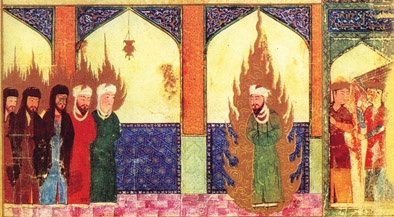 | Figure 1. Arrival of the Prophet in Jerusalem |
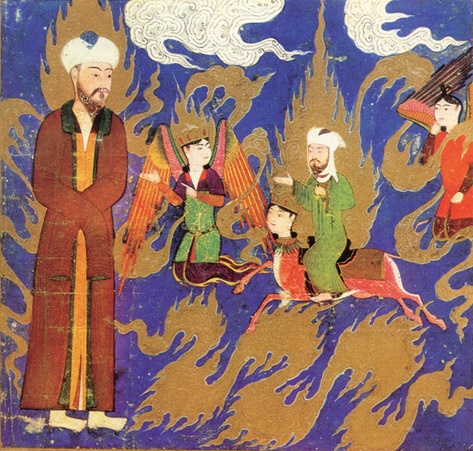 | Figure 2. The Visit of the Prophet of Islam and the Prophet Adam |
Even in the illustration, in which the prophet of Islam and several other prophets are worshiping God, this greatness is shown using the same method. The prophet of Islam who is acting as the Imam of the other prophets is the only one surrounded by halo of light and the other prophets have no circle of light. Anyhow, the halo of the prophet of Islam is a small one surrounded the head of the prophet (Figure 3). 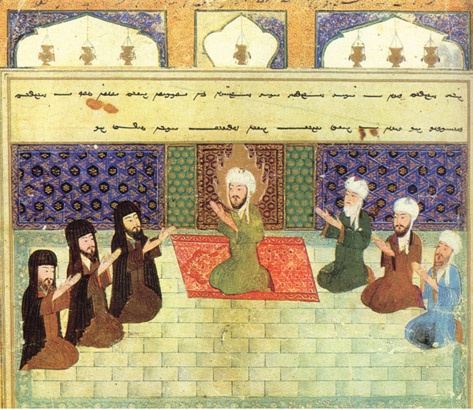 | Figure 3. Worship |
3.2.2. The Halo of the Prophet of Islam becomes Greater by ascending higher Levels of Heavens
When the prophet of Islam ascends higher levels of heavens, his halo becomes bigger until he reaches the fourth heavens and the halo embraces him and al-Buraq in whole (Figure 4). This has not however been happened in all illustrations, and in some illustrations, in which the number of characters are high, the painter avoids to use halo for the prophet. This was perhaps for avoiding any complication in the scene of the illustration to harmonize the illustrations of the book with similar simplicity. However, in these illustrations, the only prophet having a halo of light is the prophet of Islam or when the other prophets having halo, the one belonging to the Prophet Muhammad is bigger to show his superiority. 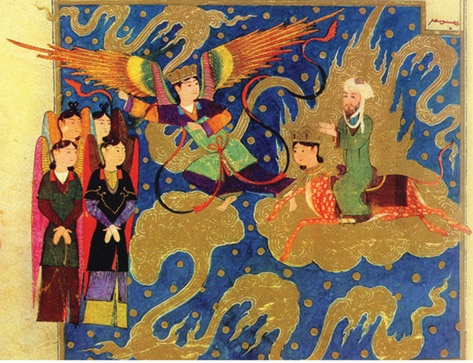 | Figure 4. Entering the Fourth Heaven |
3.2.3. The Gabriel has no Halo of Light
In the illustrations, in which Gabriel guides the prophet of Islam, Gabriel has no halo of light (Figures 1 to 4). Until the entrance to the seventh heaven, this is shown in general. However, there are exclusions. Firstly, when Gabriel visits the prophet of Islam in his house for the first time, the halo (of Gabriel which is small than that of Muhammad’s one) is perhaps to show that Gabriel is a divine angel (Figure 5). Secondly, when the prophet of Islam and Gabriel meet the angels of the heavens lined to welcome the prophet (Figure 6) the halo surrounded the head of Gabriel show his higher status to the other angels. 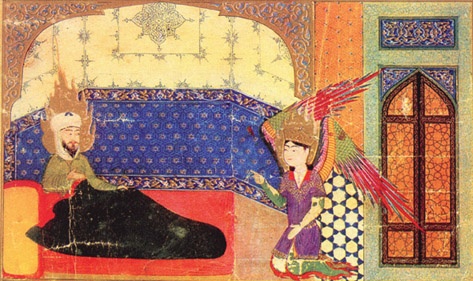 | Figure 5. The Arrival of Gabriel in Muhammad’s House |
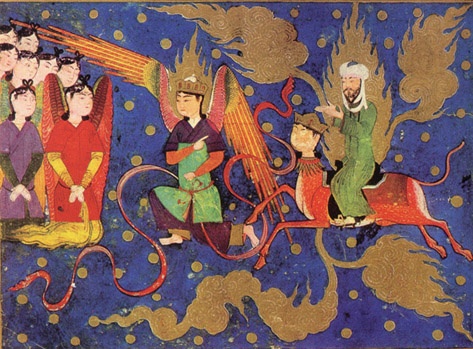 | Figure 6. The Arrival of the Prophet in the Second Heaven made of Pearl |
After arrival in the seventh heaven made entirely of light, Gabriel has a halo of light around his head until the end of the journey from the heavens to the hell. In cases, the prophet of Islam are visiting the other divine prophets, the Gabriel has no halo around his head. The lack of halo in such cases is due to two reasons: firstly, for a better recognition of the prophets from other characters. Indeed, only the divine prophets have a halo of light and the angels in the illustration including the Gabriel have no halo. Secondly, this shows the higher status of human to the angels, and it remind of the time, when God created Adam and ordered the Angels to prostrate themselves Adam. This shows the higher rank of human being. In these illustrations, the halo of the prophet of Islam is bigger than that of the other prophets. This make it easier to recognize the prophet of Islam at the first glance, and this make him distinct from other prophets (Figure 7). When Gabriel and the prophet Muhammad arrive in the seventh heaven and visit Abraham, Gabriel has again a halo of light (Figure 8). In the same illustration, the angels have also halos surrounding them. Indeed, in the seventh heaven, which is made entirely of light and is the highest level of heavens, all are liable to be enjoyed of the divine light.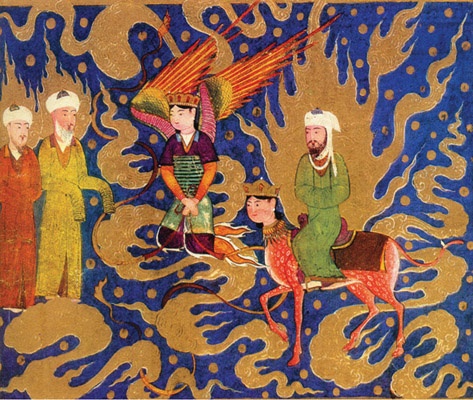 | Figure 7. The Visit of the Prophet of Islam with Noah and Idris |
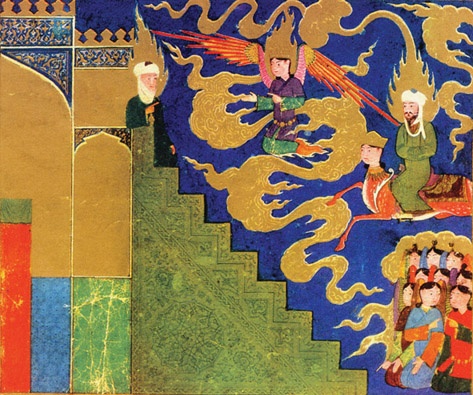 | Figure 8. The Visit of the Prophet of Islam and Abraham |
3.2.4. The Manifestation of Light Payer Altar Divine Realm
As it was mentioned, the seventh heaven is made of light (Figure 9), but when Gabriel and Muhammad reach the end of seventh heaven, Gabriel cannot continue the journey, since his wings may be burnt. What king of a light is it that burns the most important divine angel and is safe for the highest human being? The inability of the Gabriel to continue the journey shows the higher status of the prophet of Islam in comparison to that of the Gabriel. The only creature, who is permitted to enter the highest level of the heavens is that one, who is equipped with the soul of God.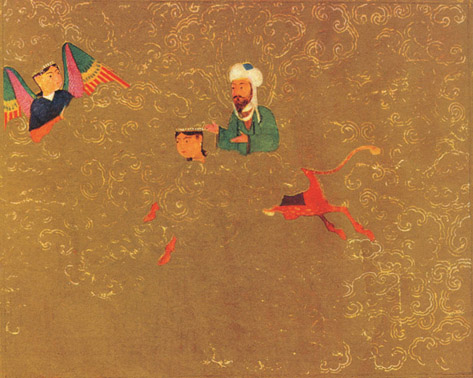 | Figure 9. The Visit of the Seventh Heaven made of Light |
After entering the highest level of heavens, the prophet of Islam arrives in the prayer altar (Figure 10). The prophet is surrounded by a golden beam embraced his whole body, and this is a halo supporting him during praying God in the blue heaven. This is the time, when the prophet is permitted to approach the divine realm of God, where no creature has been allowed to enter. The miniaturist used more space for the frame of the illustration to show the greatness of the divine realm of God, and the small nature of the greatest human being, i.e. the prophet of Islam in the realm of God. In this illustration the halo of light surrounded the prophet is greater than that of other illustrations. The divine realm is painted with cherry red color that has been more magnificent by the lights of the prophet Muhammad. The green robe of the prophet shows his greatness, and this color is a complementary color in the background in red. It seems that the background of the illustration is illuminating. The miniaturist has used these two complementary colors with one visual weight to show the supreme soul of the prophet, which is made of the divine soul. In all pages of the book, the sky is in blue violet. This color can be seen even in the paradise with lighter hue, and this color converts to red when the divine realm of God, which is the highest and most glorious place for approaching God, is depicted. In this illustration, the prophet of Islam is like a green leaf inside the heart of God, filled with golden lights (Figure 11).  | Figure 10. The Prophet Prostrate and Worship God |
 | Figure 11. Worship |
The divine lights embracing the saints of God, and the halo observed in the seven heavens have similar characteristics: they are framed in golden yellow, and filled with golden color. The lines are wavy as if they play a light music. The end of flame-like lights is faded out in the background of the painting. The light dances in the space and is faded out. It does not disturb the audience and cause you feel safe and secured from any damages.
3.2.5. Burning Fire Narrating the Ill-fated Aspect of Fire
Anywhere in the illustrations, where there is the story of damaging fire for the punishment of sinners, the miniaturist has distinguished this type of fire from the divine light using color and form. The color of this type of fire is of golden yellow framed with dark red. The collocation of these two colors reminds us of violence, hazard, warning, and disturbance. In some points, fire is framed with brown color and painting with golden yellow and the lights are painted with red. This can be seen in all images of the hell, even if the fire flames. The color red reminds us for the burning characteristic of fire and its temperature can be felt. For a better expression of this characteristic, the form assists color. In contrast to the divine lights that are painted softly, the lights of fire are sharpen, with cutting edge and damaging and seems they may harm body. The divine lights are concentrated as if they reach from plurality to unity. The edges of divine lights are in cluster form pointing to the upper parts of the illustration where is seemed is the realm of God. Contrarily, the flames of fire in these illustrations are multiple and no unity can be seen. In contrast to the divine lights that are wavy, the movements of burning fire have been show using broken lines, and contrary to the divine lights that move vertically and upwards, the fire of hell move obliquely expressing deviation, difference, and disobedience. The red edges of fire are placed in the dark brown background, which indicates a deep darkness in the hell, and intensifies the burning characteristics of this fire. These differences in the fire and light depicted in all levels of heavens can be recognized clearly (Figure 12). 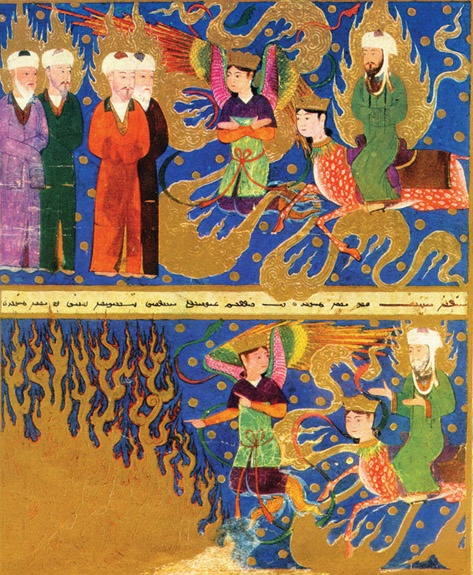 | Figure 12. The Visit of the Prophet of Islam and other Prophets and the Coasts of the Fire Sea |
The demons created from fire are depicted in red (Figure 13). The color red narrates their negative character, violence, pain, suffering, and burning. The fire emitting from the eyes and heads of the demons in the hell to frighten the sinners of the hell indicates these characteristics (Figures 14 & 15). The demons exhale fire from their mouths and this is a burning fire expressed with the same characteristics of the hellish damned fire. 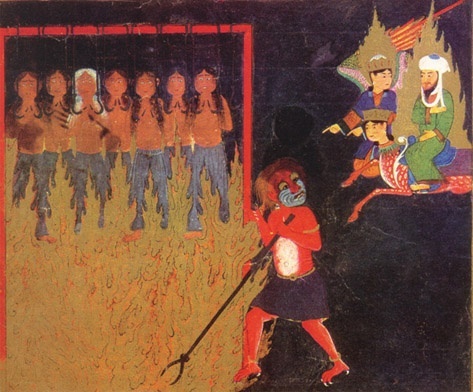 | Figure 13. The Punishment of Adulteress Women |
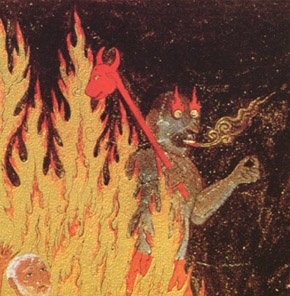 | Figure 14. The Punishment of Greedy People |
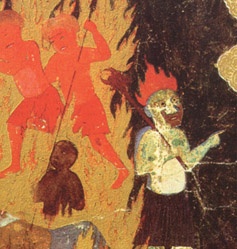 | Figure 15. The Punishment of Hypocrites |
 | Figure 16. The Punishment of Unfaithful Women the Distinction between the Divine Light and Fire of Divine Light |
In this research, we talked several times about the fire of the divine light. Therefore, it must be noted that there is a distinction between divine light and fire of divine light in the Islamic miniature. In other words, the divine light can be seen in all heavens, but the fire of the divine light surrounds only the saints of God and prophets, and it expresses the sacredness of the saints. This sacredness is shown with the motif of fire due to the cultural reasons, and this fire has divine epistemological rays endowed by God to his creatures. Divine light shows that God is present anywhere. It illuminates everywhere in form of cloud-shaped lights in the illustrations narrating the Mi’raj(ascent of the Prophet Muhammad). In these illustrations, form and color are used to meet this purpose. The halo-shaped fires around the head of prophets are in golden color pointing upwards. In contrast, the divine lights are painted with golden yellow and are more static in term of form to narrate a more silent state.
4. Conclusions
In this paper, the implicit meanings of fire have been studied based on the mystical attitudes towards this dual element. For this purpose, the rudiments of light in the Islamic – Iranian mysticism have been studied. The study of the illustrations of MirajNameh of Mirheydar, it was revealed that Iranian miniaturists were aware of the distinction between light, fire of divine light, and burning fire. Although the theoretical fundamentals of such a distinction have been faded out in the course of time, its effects have remained traditionally in the paintings, and illustrations. However, there are paintings, in which no distinction can be seen among different fires. These types of paintings are rare, and the prevailing tradition uses the distinction set forth. Principally, in most illustrations, the divine halos are in light golden color framed with white color. In contrast, the burning fire is painted with light golden yellow framed with dark colors and red showing its burning characteristics and divine wrath. The divine fire moves upwards, but burning fire is depicted obliquely. This distinction helps the reader of the manuscript to understand the illustration well without any need to read the text.
Notes
1. Khowarna (Middle Persian: xwarra, Avesta: xwarna [=farrah]) meaning glory, prosperity, and illumination is a divine power and celestial endowment conferred upon any human being to assist him to perform any work that is related to the tasks of human. However, Farrah is a celestial and divine power, which is burning, illuminating, and brilliant. Therefore, it can be concluded that Farrah must be a divine and celestial power that affects the life of people in form of power, wealth, success, etc by piety. This shows that piety of people relates this celestial power to the human world. Rulers, clergies, Aryans, prophets, etc, have their own Farrah. Until such a divine grace (Farrah-e Izadi) accompanies rulers, they can achieve victory, and when such a grace is disappeared, luck desert them [11]. 2. Mazdaism is the religion of Zoroastrians and those ones who believe in the teaching of Zoroaster. 3. It must be mentioned that in the mystical allegories, sun is the symbol of soul, moon the symbol of heart, and night the symbol of breath [14]. 4. See [5].5. Shamsais a star or sun like motif in circle form used in decorative arts including tile work, plaster work, carpentry, book writing etc[6].6. Uighur or Uyghur alphabet was derived from the old Armenian alphabet brought to the historical territory of Sogdiana, which was located around the valley of Zarafshan in Uzbekistan. This writing system was expanded in the Central Asia and used to record the literary works of Turkish language. According to the chronology of Chinese, the descendents and relatives of Hants, the Uyghur warrior who ruled the northern part of Asia from 744 to 840 AD was influenced by Manichean school and established a magnificent civilization, which survived until the gradual development of Turk – Mongol people from ninth to thirteenth century AD [7].7. Recherchessur les Langues Tatares8. According to the traditions of Shiite Imams, there was three means for the journey of the prophet Muhammad: 1- al-Buraq, 2: Razraf, 3: a kind of bird. a carpet that ascend the prophet [7]. According to the prayer of Nudba, al-Buraq was a divine steed from paradise which was smaller than a mule and bigger than a donkey, able to ascend extremely fast and cross the whole universe, and when passing the earth, he was able to cross a long distance that was observable by taking only one step [7].9. According to Moslems’ traditions, God is free of location and time, and is present at any time and place, wherever you face, God is present. No realm is for God in heavens, rather the whole universe is God’s throne, equal to the whole earth and heavens [10]. Here, the word throne means the vast created universe, and according to Quran and Islamic tradition, the purpose of Miraj(ascension) was to visit the divine indications and proximity to God. 10. Ardaviraf-nama (Pahlavi: ardaviraz): Likely, Ardaviraf was an ancient character, who was later believed to live during the rule of Sasanid Dynasty. According to the old traditions, Ardaviraf volunteered to visit the divine world to remove any doubts from Zoroastrianism. This journey lasted seven days and at the end, his soul returns to his body to let him to narrates the story of such a journey. In this journey, Ardaviraf was accompanied by Soroush and Azar (deity of fire) as his guides [11].11. Divine Comedy written by Dante Alighieri, Italian Poet, at the beginning of the fourteenth century AD. In this book, the poet travels to the world of Ghosts, and goes from the hell and purgatory by the guidance of Virgil to the heaven by Beatrice, his beloved. There is considerable resemblance between the Divine Comedy and the ascent of the prophet Muhammad. Perhaps, Dante was informed of the Latin translation of MirajNameh, since the French and Latin translation of MirajNameh from its Spanish version, translated from Arabic was available in 1264 AD. A copy of this work compiled by Benaventure of Siena exists in Bibliotheque Nationale and another one by Liber Scale Machemeti in the library of Vatican [7].
References
| [1] | M. Abu Zahra. The Last Prophet. Trans. Hussein Saberi. Mashhad: Islamic Research Foundation of Astan Qods Razavi.2004 |
| [2] | M. Adib-Behruz. Mi’raj according to Quran and Prophet’s Tradition. Publishing House of the Islamic Propaganda Organization.1995. |
| [3] | Gaston Bachelard, La psychanalyse du feu. Trans. Jalal Sattari. Tehran: Tous Publisher.1985. |
| [4] | Titus Burckhardt,. Principeset Méthodes de l’artsacré. Trans. Jalal Sattari. Tehran: Soroush Publisher.1997 |
| [5] | H. BolkhariGhahi. The Mystical Rudiments of Islamic Art and Architecture. Second Vol.: The Alchemy of Imagination. Tehran: SurehMehr (HozehHonari of the Islamic Propaganda Organization).2005. |
| [6] | M. R. Riazi. Pictorial Encyclopedia of Iranian Art Terms. Tehran: Al-Zahra University Press, 1996. |
| [7] | M. R Seguy, The Miraculous Journey of Mahomet. Trans. Mahnaz Shayestehfar. Tehran: Islamic Art Research Center.2006. |
| [8] | The Masterpieces of Iranian Miniatures. Tehran: Contemporary Art Museum.2005. |
| [9] | S. M. H Tabatabai. Tafsir Al-Mizan (Al-Mizan Exegesis). Trans. Board of Translators. 2nd ed. Tehran: Raja Publisher, 1987. |
| [10] | Quran. Trans. Mehdi Elahi Ghomshei. Tehran: Farhang Publisher, 1996. |
| [11] | Khosrow Gholizadeh. Iranian Myths Dictionary based on Pahlavi Texts. Tehran: Ketab Parse Publisher,2008. |
| [12] | B. & M. T. Shora Kamrani. The Meanings of Fire Motifs. Honarnameh Quarterly of the University of Art. No. 23. Pp. 108 – 131, 2004. |
| [13] | Henry Corbin. Terre Celeste et corps de resurrection. Tran. Z. Dehshiri. Tehran: Tahouri Publisher, 1995. |
| [14] | Rene Guenon. Le Symbolisme de la Croix. Trans. B. Alikhani. Tehran: Soroush Publisher,1995. |
| [15] | Henry Corbin, “Illuminative Wisdom in Iran in the 12th Century AD”. Journal of the Faculty of Humanities of Tehran University. 6th Year. First Issue. |
| [16] | Samad Movahed. The Origin of Illuminative Wisdom. Forouzan Publisher,1995. |
| [17] | M.J Yahaghi. Dictionary of Mythology. Tehran: Soroush Publisher,1996. |

















 Abstract
Abstract Reference
Reference Full-Text PDF
Full-Text PDF Full-text HTML
Full-text HTML